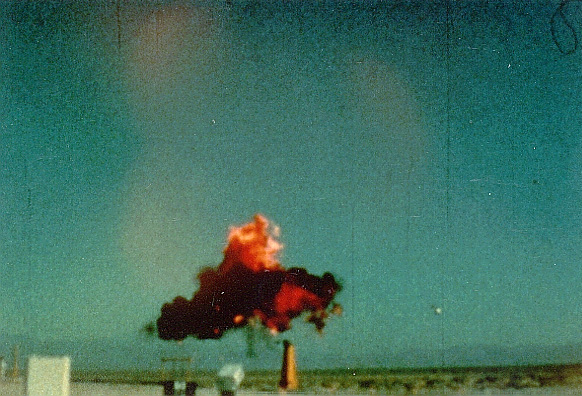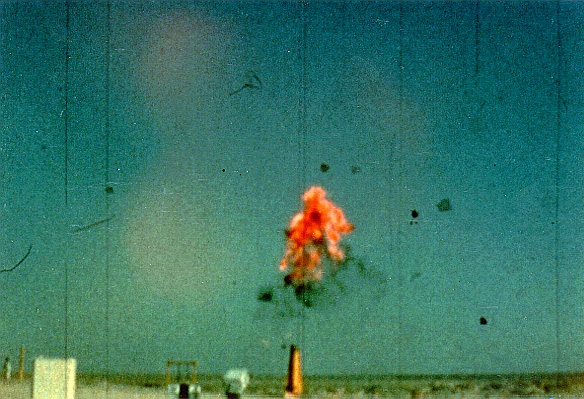
GTA Fuel Enhancer History
Two pictures from a film of a 1983 test at the Naval Weapons Center, China Lake, California. Two canisters of JP-5 aviation fuel (one untreated and the other treated) were detonated by 50 caliber, armor-piercing, incendiary rounds fired at metal plates affixed to the front of the containers. The canister without the active ingredient of Viscon made considerably more smoke when it exploded. Note the size of the black cloud around the fire ball. The canister with 50ppm of the active ingredient left considerably less smoke.

Detonation of untreated JP-5 aviation fuel. Notice the size of the smoke cloud.

Detonation of treated JP-5 aviation fuel.
Test Background:
In 1980 GTA began its anti-misting fuel research for the FAA. The company proved during that program that the Viscon high molecular weight polymer was superior in performance to ICI’s FM9, the FAA’s candidate anti-misting fuel additive.
In 1981 GTA tested a series of anti-misting fuel additives for the US Army MERADCOM. The goal was to determine which polymer offered the greatest protection against a fuel mist and fire ball explosions. The high molecular polymer outperformed competing technologies.
In 1983, GTA, under a contract for NRL, applied what it had learned about anti-misting fuel to the US Navy requirement for a non-exploding fuel for its aircraft. In the earlier work for the FAA and the US Army, GTA discovered that the concentration of the additive being used by ICI and the FAA was higher than necessary. The higher concentration interfered with the proper combustion of the fuel. In the program for the Navy, GTA focused on the effect of lower concentrations of polymer.
The Naval Weapons Center at China Lake performed gunfire tests on treated and untreated fuels. GTA discovered that a low concentration (50ppm) of the Viscon polymer significantly changed the nature of the combustion. These discoveries were not applied to internal combustion engines for a number of year.
Following the China Lake tests, GTA met with Dr. Levine, the head of the Fire Research Center at the Bureau of Standards. After reviewing the pictures of the test including those above, Dr. Irvine concluded that the polymer used suppressed the formation of fine droplets. He said that the fuel fines burn explosively like vapor. This can be seen in the picture of the untreated fuel above.
In search of combustion literature, the company found that it was well known that sub-40 micron droplets burn explosively like a vapor. While droplets larger and 40 microns burn diffusely from droplet to droplet with a much slower rate of energy release.
If you haven't arrived at this page from the GTA home page, you can see more about GTA Fuel Enhancer at: www.apdinc.com/GTAfuel.html. Use the BACK arrow if you have come from the home page or a GTA sub-directory.
Copyright 2000, GTA Technologies, Inc., All Rights Reserved.